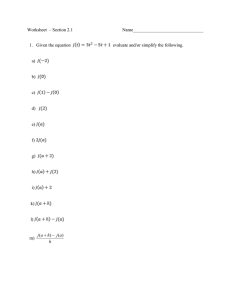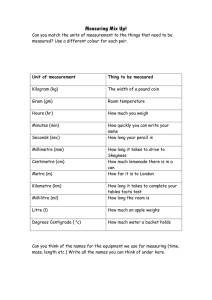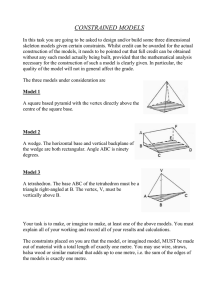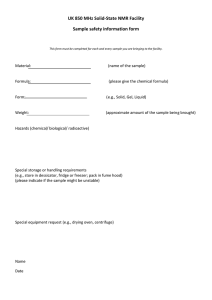29.8 2001 ASHRAE Fundamentals Handbook (SI)
advertisement
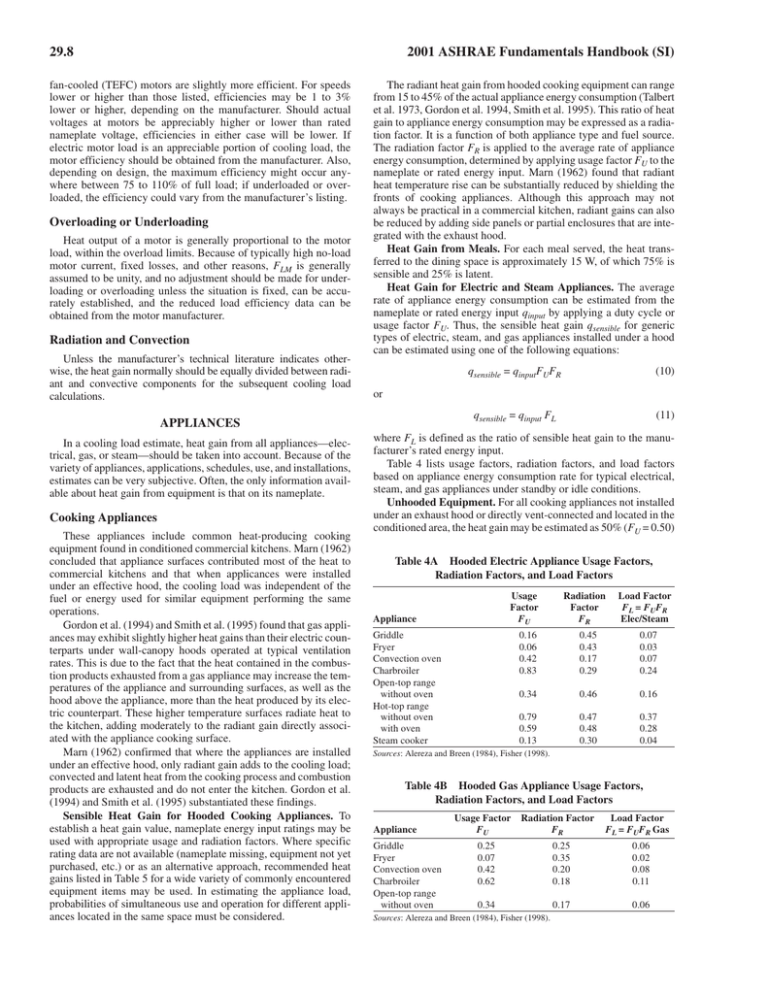
29.8 2001 ASHRAE Fundamentals Handbook (SI) fan-cooled (TEFC) motors are slightly more efficient. For speeds lower or higher than those listed, efficiencies may be 1 to 3% lower or higher, depending on the manufacturer. Should actual voltages at motors be appreciably higher or lower than rated nameplate voltage, efficiencies in either case will be lower. If electric motor load is an appreciable portion of cooling load, the motor efficiency should be obtained from the manufacturer. Also, depending on design, the maximum efficiency might occur anywhere between 75 to 110% of full load; if underloaded or overloaded, the efficiency could vary from the manufacturer’s listing. Overloading or Underloading Heat output of a motor is generally proportional to the motor load, within the overload limits. Because of typically high no-load motor current, fixed losses, and other reasons, FLM is generally assumed to be unity, and no adjustment should be made for underloading or overloading unless the situation is fixed, can be accurately established, and the reduced load efficiency data can be obtained from the motor manufacturer. Radiation and Convection Unless the manufacturer’s technical literature indicates otherwise, the heat gain normally should be equally divided between radiant and convective components for the subsequent cooling load calculations. The radiant heat gain from hooded cooking equipment can range from 15 to 45% of the actual appliance energy consumption (Talbert et al. 1973, Gordon et al. 1994, Smith et al. 1995). This ratio of heat gain to appliance energy consumption may be expressed as a radiation factor. It is a function of both appliance type and fuel source. The radiation factor FR is applied to the average rate of appliance energy consumption, determined by applying usage factor FU to the nameplate or rated energy input. Marn (1962) found that radiant heat temperature rise can be substantially reduced by shielding the fronts of cooking appliances. Although this approach may not always be practical in a commercial kitchen, radiant gains can also be reduced by adding side panels or partial enclosures that are integrated with the exhaust hood. Heat Gain from Meals. For each meal served, the heat transferred to the dining space is approximately 15 W, of which 75% is sensible and 25% is latent. Heat Gain for Electric and Steam Appliances. The average rate of appliance energy consumption can be estimated from the nameplate or rated energy input qinput by applying a duty cycle or usage factor FU. Thus, the sensible heat gain qsensible for generic types of electric, steam, and gas appliances installed under a hood can be estimated using one of the following equations: Cooking Appliances These appliances include common heat-producing cooking equipment found in conditioned commercial kitchens. Marn (1962) concluded that appliance surfaces contributed most of the heat to commercial kitchens and that when applicances were installed under an effective hood, the cooling load was independent of the fuel or energy used for similar equipment performing the same operations. Gordon et al. (1994) and Smith et al. (1995) found that gas appliances may exhibit slightly higher heat gains than their electric counterparts under wall-canopy hoods operated at typical ventilation rates. This is due to the fact that the heat contained in the combustion products exhausted from a gas appliance may increase the temperatures of the appliance and surrounding surfaces, as well as the hood above the appliance, more than the heat produced by its electric counterpart. These higher temperature surfaces radiate heat to the kitchen, adding moderately to the radiant gain directly associated with the appliance cooking surface. Marn (1962) confirmed that where the appliances are installed under an effective hood, only radiant gain adds to the cooling load; convected and latent heat from the cooking process and combustion products are exhausted and do not enter the kitchen. Gordon et al. (1994) and Smith et al. (1995) substantiated these findings. Sensible Heat Gain for Hooded Cooking Appliances. To establish a heat gain value, nameplate energy input ratings may be used with appropriate usage and radiation factors. Where specific rating data are not available (nameplate missing, equipment not yet purchased, etc.) or as an alternative approach, recommended heat gains listed in Table 5 for a wide variety of commonly encountered equipment items may be used. In estimating the appliance load, probabilities of simultaneous use and operation for different appliances located in the same space must be considered. (10) qsensible = qinput FL (11) or APPLIANCES In a cooling load estimate, heat gain from all appliances—electrical, gas, or steam—should be taken into account. Because of the variety of appliances, applications, schedules, use, and installations, estimates can be very subjective. Often, the only information available about heat gain from equipment is that on its nameplate. qsensible = qinputFUFR where FL is defined as the ratio of sensible heat gain to the manufacturer’s rated energy input. Table 4 lists usage factors, radiation factors, and load factors based on appliance energy consumption rate for typical electrical, steam, and gas appliances under standby or idle conditions. Unhooded Equipment. For all cooking appliances not installed under an exhaust hood or directly vent-connected and located in the conditioned area, the heat gain may be estimated as 50% (FU = 0.50) Table 4A Hooded Electric Appliance Usage Factors, Radiation Factors, and Load Factors Usage Factor FU Appliance Griddle Fryer Convection oven Charbroiler Open-top range without oven Hot-top range without oven with oven Steam cooker Radiation Factor FR Load Factor FL = FUFR Elec/Steam 0.16 0.06 0.42 0.83 0.45 0.43 0.17 0.29 0.07 0.03 0.07 0.24 0.34 0.46 0.16 0.79 0.59 0.13 0.47 0.48 0.30 0.37 0.28 0.04 Sources: Alereza and Breen (1984), Fisher (1998). Table 4B Hooded Gas Appliance Usage Factors, Radiation Factors, and Load Factors Appliance Griddle Fryer Convection oven Charbroiler Open-top range without oven Usage Factor FU Radiation Factor FR Load Factor FL = FUFR Gas 0.25 0.07 0.42 0.62 0.25 0.35 0.20 0.18 0.06 0.02 0.08 0.11 0.34 0.17 0.06 Sources: Alereza and Breen (1984), Fisher (1998). Nonresidential Cooling and Heating Load Calculation Procedures or the rated hourly input, regardless of the type of energy or fuel used. On average, 34% of the heat may be assumed to be latent and the remaining 66% sensible. Note that cooking appliances ventilated by “ductless” hoods should be treated as unhooded appliances from the perspective of estimating heat gain. In other words, all energy consumed by the appliance and all moisture produced by the cooking process is introduced to the kitchen as a sensible or latent cooling load. Recommended Heat Gain Values. As an alternative procedure, Table 5 lists recommended rates of heat gain from typical commercial cooking appliances. The data in the “with hood” columns assume installation under a properly designed exhaust hood connected to a mechanical fan exhaust system. Hospital and Laboratory Equipment Hospital and laboratory equipment items are major sources of heat gain in conditioned spaces. Care must be taken in evaluating the probability and duration of simultaneous usage when many components are concentrated in one area, such as a laboratory, an operating room, etc. Commonly, heat gain from equipment in a laboratory ranges from 50 to 220 W/m2 or, in laboratories with outdoor exposure, as much as four times the heat gain from all other sources combined. Medical Equipment. It is more difficult to provide generalized heat gain recommendations for medical equipment than for general office equipment because medical equipment is much more varied in type and in application. Some heat gain testing has been done and can be presented, but the equipment included represents only a small sample of the type of equipment that may be encountered. The data presented for medical equipment in Table 6 are relevant for portable and bench-top equipment. Medical equipment is very specific and can vary greatly from application to application. The data are presented to provide guidance in only the most general sense. For large equipment, such as MRI, engineers must obtain heat gain from the manufacturer. Laboratory Equipment. Equipment in laboratories is similar to medical equipment in that it will vary significantly from space to space. Chapter 13 of the 1999 ASHRAE Handbook—Applications discusses heat gain from equipment, stating that it may range from 50 to 270 W/m2 in highly automated laboratories. Table 7 lists some values for laboratory equipment, but, as is the case for medical equipment, it is for general guidance only. Wilkins and Cook (1999) also examined laboratory equipment heat gains. Office Equipment Computers, printers, copiers, calculators, checkwriters, posting machines, etc., can generate 9 to 13 W/m2 for general offices or 18 to 22 W/m2 for purchasing and accounting departments. ASHRAE Research Project 822 developed a method to measure the actual heat gain from equipment in buildings and the radiant/convective percentages (Hosni et al. 1998; Jones et al. 1998). This methodology was then incorporated into ASHRAE Research Project 1055 and applied to a wide range of equipment (Hosni et al. 1999) as a follow-up to independent research by Wilkins et al. (1991) and Wilkins and McGaffin (1994). Komor (1997) found similar results. Analysis of measured data showed that results for office equipment could be generalized, but results from laboratory and hospital equipment proved too diverse. The following general guidelines for office equipment are a result of these studies. Nameplate Versus Measured Energy Use. Nameplate data rarely reflect the actual power consumption of office equipment. Actual power consumption of such equipment is assumed equal to the total (radiant plus convective) heat gain, but the ratio of such energy to the nameplate value varies widely. ASHRAE Research Project 1055 (Hosni et al. 1999) found that for general office equipment with nameplate power consumption of less than 1000 W, the 29.9 actual ratio of total heat gain to nameplate ranged from 25% to 50%, but when all tested equipment is considered, the range is broader. Generally, if the nameplate value is the only information known and no actual heat gain data are available for similar equipment, it would be conservative to use 50% of nameplate as heat gain and more nearly correct if 25% of nameplate were used. Much better results can be obtained, however, by considering the heat gain as being predictable based on the type of equipment. Office equipment is grouped into categories such as computers, monitors, printers, facsimile machines, and copiers, with heat gain results within each group analyzed to establish patterns. Computers. Based on tests by Hosni et al. (1999) and Wilkins and McGaffin (1994), nameplate values on computers should be ignored when performing cooling load calculations. Table 8 presents typical heat gain values for computers with varying degrees of safety factor. Monitors. Based on monitors tested by Hosni et al. (1999), heat gain correlates approximately with screen size as qmon = 0.2S – 20 (12) where qmon = heat gain from monitor, W S = nominal screen size, mm Wilkins and McGaffin tested ten monitors (330 to 480 mm), finding the average heat gain value to be 60 W. This testing was done in 1992 when DOS was prevalent and the Windows™ operating system was just being introduced. Monitors displaying Windows consumed more power than those displaying DOS. Table 8 tabulates typical values. Laser Printers. Hosni et al. (1999) found that the power consumed by laser printers, and therefore the heat gain, depended largely on the level of throughput for which the printer was designed. It was observed that smaller printers are used more intermittently and that larger printers may run continuously for longer periods. Table 9 presents data on laser printers. These data can be applied by taking the value for continuous operation and then applying an appropriate diversity factor. This would likely be most appropriate for larger open office areas. Another approach could be to take the value that most closely matches the expected operation of the printer with no diversity. This may be appropriate when considering a single room or small area. Copiers. Hosni et al. (1999) also tested five copy machines considered to be of two types, desktop and office (freestanding highvolume copiers). Larger machines used in production environments were not addressed. Table 9 summarizes of the results. It was observed that desktop copiers rarely operated continuously but that office copiers frequently operated continuously for periods of an hour or more. Miscellaneous Office Equipment. Table 10 presents data on miscellaneous office equipment such as vending machines and mailing equipment. Diversity. The ratio of the measured peak electrical load at the equipment panels to the sum of the maximum electrical load of each individual item of equipment is the usage diversity. A small, one- or two-person office containing equipment listed in Tables 8 through 10 can be expected to contribute heat gain to the space at the sum of the appropriate listed values. Progressively larger areas with many equipment items will always experience some degree of usage diversity resulting from whatever percentage of such equipment is not in operation at any given time. Wilkins and McGaffin (1994) measured diversity in 23 areas within five different buildings totaling over 25 600 m2. Diversity was found to range between 37 and 78%, with the average (normalized based on area) being 46%. Figure 4 illustrates the relationship between nameplate, the sum of the peaks, and the actual electrical load with diversity accounted for, based on the average of the total 29.10 2001 ASHRAE Fundamentals Handbook (SI) Table 5 Recommended Rates of Heat Gain From Typical Commercial Cooking Appliances Energy Rate, W Appliance Size Rated Standby Electric, No Hood Required Barbeque (pit), per kilogram of food capacity 36 to 136 kg 88 Barbeque (pressurized) per kilogram of food capacity 20 kg 210 Blender, per litre of capacity 1.0 to 3.8 L 480 Braising pan, per litre of capacity 102 to 133 L 110 Cabinet (large hot holding) 0.46 to 0.49 m3 2080 Cabinet (large hot serving) 1.06 to 1.15 m3 2000 2030 Cabinet (large proofing) 0.45 to 0.48 m3 900 Cabinet (small hot holding) 0.09 to 0.18 m3 Cabinet (very hot holding) 0.49 m3 6150 Can opener 170 Coffee brewer 12 cup/2 brnrs 1660 Coffee heater, per boiling burner 1 to 2 brnrs 670 Coffee heater, per warming burner 1 to 2 brnrs 100 Coffee/hot water boiling urn, per litre of capacity 11 L 120 Coffee brewing urn (large), per litre of capacity 22 to 38 L 660 Coffee brewing urn (small), per litre of capacity 10 L 420 Cutter (large) 460 mm bowl 750 Cutter (small) 360 mm bowl 370 Cutter and mixer (large) 28 to 45 L 3730 Dishwasher (hood type, chemical sanitizing), per 100 dishes/h 950 to 2000 dishes/h 380 Dishwasher (hood type, water sanitizing), per 100 dishes/h 950 to 2000 dishes/h 380 Dishwasher (conveyor type, chemical sanitizing), per 100 dishes/h 5000 to 9000 dishes/h 340 Dishwasher (conveyor type, water sanitizing), per 100 dishes/h 5000 to 9000 dishes/h 340 Display case (refrigerated), per cubic metre of interior 0.17 to 1.9 m3 1590 Dough roller (large) 2 rollers 1610 Dough roller (small) 1 roller 460 Egg cooker 12 eggs 1800 Food processor 2.3 L 520 Food warmer (infrared bulb), per lamp 1 to 6 bulbs 250 2930 Food warmer (shelf type), per square metre of surface 0.28 to 0.84 m3 Food warmer (infrared tube), per metre of length 1.0 to 2.1 m 950 Food warmer (well type), per cubic metre of well 20 to 70 L 37400 Freezer (large) 2.07 m3 1340 Freezer (small) 0.51 m3 810 Griddle/grill (large), per square metre of cooking surface 0.43 to 1.1 m2 29000 Griddle/grill (small), per square metre of cooking surface 0.20 to 0.42 m2 26200 Hot dog broiler 48 to 56 hot dogs 1160 Hot plate (double burner, high speed) 4900 Hot plate (double burner stockpot) 4000 Hot plate (single burner, high speed) 2800 Hot water urn (large), per litre of capacity 53 L 130 Hot water urn (small), per litre of capacity 7.6 L 230 Ice maker (large) 100 kg/day 1090 Ice maker (small) 50 kg/day 750 Microwave oven (heavy duty, commercial) 20 L 2630 Microwave oven (residential type) 30 L 600 to 1400 Mixer (large), per litre of capacity 77 L 29 Mixer (small), per litre of capacity 11 to 72 L 15 Press cooker (hamburger) 300 patties/h 2200 780 Refrigerator (large), per cubic metre of interior space 0.71 to 2.1 m3 Refrigerator (small) per cubic metre of interior space 0.17 to 0.71 m3 1730 Rotisserie 300 hamburgers/h 3200 Serving cart (hot), per cubic metre of well 50 to 90 L 21200 Serving drawer (large) 252 to 336 dinner rolls 1100 Serving drawer (small) 84 to 168 dinner rolls 800 Skillet (tilting), per litre of capacity 45 to 125 L 180 Slicer, per square metre of slicing carriage 0.06 to 0.09 m2 2150 Soup cooker, per litre of well 7 to 11 L 130 Steam cooker, per cubic metre of compartment 30 to 60 L 214000 Steam kettle (large), per litre of capacity 76 to 300 L 95 Steam kettle (small), per litre of capacity 23 to 45 L 260 Syrup warmer, per litre of capacity 11 L 87 — — — — — — — — — — — — — — — — — — — — — — — — — — — — — — — — — — — — — — — — — — — — — — — — — — — — — — — — — — — — — — Recommended Rate of Heat Gain,a W Without Hood Sensible Latent With Hood Total 57 31 88 71 35 106 310 160 470 55 29 84 180 100 280 180 90 270 180 90 270 80 40 120 550 280 830 170 — 170 1100 560 1660 440 230 670 66 34 100 79 41 120 440 220 660 280 140 420 750 — 750 370 — 370 3730 — 3730 50 110 160 56 123 179 41 97 138 44 108 152 640 0 640 1610 — 1610 460 — 460 850 570 1420 520 — 520 250 — 250 2330 600 2930 950 — 950 12400 6360 18760 540 — 540 320 — 320 1940 1080 3020 1720 970 2690 100 50 150 2290 1590 3880 1870 1300 3170 1310 910 2220 50 16 66 87 30 117 2730 — 2730 1880 — 1880 2630 — 2630 600 to 1400 — 600 to 1400 29 — 29 15 — 15 1450 750 2200 310 — 310 690 — 690 2110 1090 3200 7060 3530 10590 140 10 150 100 10 110 90 50 140 2150 — 2150 45 24 69 17000 10900 27900 7 5 12 21 14 35 29 16 45 Sensible 27 33 150 40 85 82 82 37 250 0 530 210 32 38 210 130 0 0 0 50 56 44 50 0 0 0 460 0 250 820 950 6000 0 0 1080 940 48 1830 1490 1040 21 37 0 0 0 0 0 0 700 0 0 1020 3390 45 33 66 680 21 8120 4 10 14 Nonresidential Cooling and Heating Load Calculation Procedures 29.11 Table 5 Recommended Rates of Heat Gain From Typical Commercial Cooking Appliances (Concluded) Recommended Rate of Heat Gain,a W Energy Rate, W Appliance Size Toaster (bun toasts on one side only) Toaster (large conveyor) Toaster (small conveyor) Toaster (large pop-up) Toaster (small pop-up) Waffle iron Electric, Exhaust Hood Required Broiler (conveyor infrared), per square metre of cooking area Broiler (single deck infrared), per square metre of broiling area Charbroiler, per linear metre of cooking surface Fryer (deep fat) Fryer (pressurized), per kilogram of fat capacity Griddle, per linear metre of cooking surface Oven (full-szie convection) Oven (large deck baking with 15.2 m3 decks), per cubic metre of oven spacer Oven (roasting), per cubic metre of oven space Oven (small convection), per cubic metre of oven space Oven (small deck baking with 7.7 m3 decks), per cubic metre of oven space Open range (top), per 2 element section Range (hot top/fry top), per square metre of cooking surface Range (oven section), per cubic metre of oven space Gas, No Hood Required Broiler, per square metre of broiling area Cheese melter, per square metre of cooking surface Dishwasher (hood type, chemical sanitizing), per 100 dishes/h Dishwasher (hood type, water sanitizing), per 100 dishes/h Dishwasher (conveyor type, chemical sanitizing), per 100 dishes/h Dishwasher (conveyor type, water sanitizing), per 100 dishes/h Griddle/grill (large), per square metre of cooking surface Griddle/grill (small), per square metre of cooking surface Hot plate Oven (pizza), per square metre of hearth Gas, Exhaust Hood Required Braising pan, per litre of capacity Broiler, per square metre of broiling area Broiler (large conveyor, infrared), per square metre of cooking area/minute Broiler (standard infrared), per square metre of broiling area Charbroiler (large), per linear metre of cooking area Fryer (deep fat) Oven (bake deck), per cubic metre of oven space Griddle, per linear metre of cooling surface Oven (full-size convection) Oven (pizza), per square metre of oven hearth Oven (roasting), per cubic metre of oven space Oven (twin bake deck), per cubic metre of oven space Range (burners), per 2 burner section Range (hot top or fry top), per square metre of cooking surface Range (large stock pot) Range (small stock pot) Range top, open burner (per 2 element section) Steam Compartment steamer, per kilogram of food capacity/h Dishwasher (hood type, chemical sanitizing), per 100 dishes/h Dishwasher (hood type, water sanitizing), per 100 dishes/h Dishwasher (conveyor, chemical sanitizing), per 100 dishes/h Dishwasher (conveyor, water sanitizing), per 100 dishes/h Steam kettle, per litre of capacity 1400 buns/h 720 slices/h 360 slices/h 10 slice 4 slice 0.05 m2 Without Hood Rated Standby Sensible Latent With Hood Total Sensible 1500 3200 2100 5300 2470 1640 — — — — — — 800 850 560 2810 1310 700 710 750 490 2490 1160 940 1510 1600 1050 5300 2470 1640 480 510 340 1700 790 520 0.43 to 1.3 m3 60800 34200 10600 14000 1010 18800 12000 17300 — — 8900 850 — 3000 5000 — — — — — — — — — — — — — — — — — — — — — — — — — 12100 6780 2700 350 38 1350 850 710 0.22 to 0.66 m3 0.04 to 0.15 m3 0.22 to 0.66 m3 28300 107000 28700 — — — — — — — — — — — — 1170 1520 1170 2 to 10 elements 0.36 to 0.74 m2 0.12 to 0.32 m3 4100 22900 40600 1350 — — — — — — — — — — — 620 8500 1660 0.25 0.23 to 0.47 950 to 2000 dishes/h 950 to 2000 dishes/h 46600 32500 510 510 190b 190b 190b 190b 16800 11600 150 170 9030 3400 59 64 25830 15000 209 234 3840 2680 67 73 5000 to 9000 dishes/h 5000 to 9000 dishes/h 0.43 to 1.1 m2 0.23 to 0.42 m2 2 burners 0.59 to 1.2 m2 400 400 53600 45400 5630 14900 190b 190b 1040 1040 390b 190b 97 110 3600 3050 3430 1970 21 23 1930 1610 1020 690 118 133 5530 4660 4450 2660 38 41 1450 1260 1000 270 102 to 133 L 0.34 to 0.36 m3 3050 68900 190b 1660 — — — — — — 750 5690 0.19 to 9.5 m2 0.22 to 0.87 m2 0.6 to 2.4 m 15 to 23 kg 0.15 to 0.46 m3 0.6 to 2.4 m 162000 61300 34600 23500 79400 24000 20500 22800 44500 45400 9840 37200 29300 11700 11700 6270 1660 21000 1640 190b 6060 8600 190b 190b 190b 390 1040 580 390 4000 — — — — — — — — — — — — — — — — — — — — — — — — — — — — — — — — — — — — — — — — — — — — — 16900 5040 3650 560 1450 1540 1670 410 800 810 1930 10700 5740 2290 640 14 260 290 41 44 12 9 110 120 97 108 8 23 370 410 138 152 20 7 120 130 44 50 6 0.19 to 9.5 m2 0.24 to 0.91 m2 0.6 to 2.4 m 15 to 23 kg oil 6 to 15 kg 0.6 to 2.4 m 0.86 to 2.4 m2 0.26 to 0.79 m3 0.31 to 0.61 m3 2 to 10 burners 0.26 to 0.74 m3 3 burners 2 burners 2 to 6 elements 21 to 204 kg 950 to 2000 dishes/h 950 to 2000 dishes/h 5000 to 9000 dishes/h 5000 to 9000 dishes/h 12 to 30 L 180 920 920 350 350 160 — — — — — — Sources: Alereza and Breen (1984), Fisher (1998). a In some cases, heat gain data are given per unit of capacity. In those cases, the heat gain is calculated by: q = (recommended heat gain per unit of capacity) × (capacity) input rating is given for entire appliance regardless of size. b Standby 29.12 2001 ASHRAE Fundamentals Handbook (SI) Table 6 Recommended Heat Gain from Typical Medical Equipment Nameplate, W Equipment Anesthesia system Blanket warmer Blood pressure meter Blood warmer ECG/RESP Electrosurgery Endoscope Harmonical scalpel Hysteroscopic pump Laser sonics Optical microscope Pulse oximeter Stress treadmill Ultrasound system Vacuum suction X-ray system X-ray system X-ray system 250 500 180 360 1440 1000 1688 230 180 1200 330 72 N/A 1800 621 968 1725 2070 Table 8 Recommended Heat Gain from Typical Computer Equipment Peak, W Average, W 177 504 33 204 54 147 605 60 35 256 65 21 198 1063 337 166 221 29 114 50 109 596 59 34 229 63 20 173 1050 302 82 480 18 534 Source: Hosni et al. (1999) Table 7 Recommended Heat Gain from Typical Laboratory Equipment Equipment Analytical balance Centrifuge Centrifuge Centrifuge Electrochemical analyzer Electrochemical analyzer Flame photometer Fluorescent microscope Fluorescent microscope Function generator Incubator Incubator Incubator Orbital shaker Oscilloscope Oscilloscope Rotary evaporator Rotary evaporator Spectronics Spectrophotometer Spectrophotometer Spectrophotometer Spectro fluorometer Thermocycler Thermocycler Tissue culture Tissue culture Nameplate, W 7 138 288 5500 50 100 180 150 200 58 515 600 3125 100 72 345 75 94 36 575 200 N/A 340 1840 N/A 475 2346 Peak, W Average, W 7 89 136 1176 45 85 107 144 205 29 461 479 1335 16 38 99 74 29 31 106 122 127 405 965 233 132 1178 7 87 132 730 44 84 105 143 178 29 451 264 1222 16 38 97 73 28 31 104 121 125 395 641 198 46 1146 Source: Hosni et al. (1999) area tested. Data on actual diversity can be used as a guide, but diversity varies significantly with occupancy. The proper diversity factor for an office of mail order catalog telephone operators is different from that for an office of sales representatives who travel regularly. Heat Gain per Unit Area. Wilkins (1998) and Wilkins and Hosni (2000) summarized recent research on a heat gain per unit area basis. The diversity testing showed that the actual heat gain per unit area, or load factor, ranged from 4.7 to 11.6 W/m2, with an average (normalized based on area) of 8.7 W/m2. Spaces tested Continuous, Energy Saver Mode, W W Computersa Average value Conservative value Highly conservative value 55 65 75 20 25 30 Monitorsb Small monitor (330 to 380 mm) Medium monitor (400 to 460 mm) Large monitor (480 to 510 mm) 55 70 80 0 0 0 Sources: Hosni et al. (1999), Wilkins and McGaffin (1994). aBased on 386, 486, and Pentium grade. bTypical values for monitors displaying Windows environment. Table 9 Recommended Heat Gain from Typical Laser Printers and Copiers Continuous, W 1 page per min., W Idle, W 130 215 320 550 75 100 160 275 10 35 70 125 400 1,100 85 400 20 300 Laser Printers Small desktop Desktop Small office Large office Copiers Desktop copier Office copier Source: Hosni et al. (1999). Table 10 Recommended Heat Gain from Miscellaneous Office Equipment Appliance Mail-processing equipment Folding machine Inserting machine, 3,600 to 6,800 pieces/h Labeling machine, 1,500 to 30,000 pieces/h Postage meter Vending machines Cigarette Cold food/beverage Hot beverage Snack Other Bar code printer Cash registers Check processing workstation, 12 pockets Coffee maker, 10 cups Microfiche reader Microfilm reader Microfilm reader/printer Microwave oven, 28 L Paper shredder Water cooler, 30 L/h Maximum Input Recommended Rate Rating, W of Heat Gain, W 125 600 to 3300 80 390 to 2150 600 to 6600 390 to 4300 230 150 72 1150 to 1920 1725 240 to 275 72 575 to 960 862 240 to 275 440 60 4800 370 48 2470 1500 85 520 1150 1050 sens., 450 latent 85 520 1150 600 250 to 3000 400 200 to 2420 700 350 Nonresidential Cooling and Heating Load Calculation Procedures Table 12 Cooling Load Estimates for Various Office Load Densities Table 11 Recommended Load Factors for Various Types of Offices Load Density of Office Load Factor, W/m2 Description 5.4 Assumes 15.5 m2/workstation (6.5 workstations per 100 m2) with computer and monitor at each plus printer and fax. Computer, monitor, and fax diversity 0.67, printer diversity 0.33. 10.8 Assumes 11.6 m2/workstation (8.5 workstations per 100 m2) with computer and monitor at each plus printer and fax. Computer, monitor, and fax diversity 0.75, printer diversity 0.50. Light Medium Medium/ Heavy 16.1 Heavy 21.5 Assumes 9.3 m2/workstation (11 workstations per 100 m2) with computer and monitor at each plus printer and fax. Computer and monitor diversity 0.75, printer and fax diversity 0.50. Assumes 7.8 m2/workstation (13 workstations per 100 m2) with computer and monitor at each plus printer and fax. Computer and monitor diversity 1.0, printer and fax diversity 0.50. Source: Wilkins and McGaffin (1994). 29.13 Num- Each, ber W Total, Diver- Load, W sity W Light Load Densitya Computers Monitors Laser printer—small desk top Fax machine Total Area Load 6 6 1 1 55 55 130 15 330 330 130 15 0.67 0.67 0.33 0.67 220 220 43 10 494 Recommended equipment load factor = 5.4 W/m2 Medium Load Densitya Computers Monitors Laser printer—desk Fax machine Total Area Load 8 8 1 1 65 70 215 15 520 560 215 15 0.75 0.75 0.5 0.75 390 420 108 11 929 Recommended equipment load factor = 10.8 W/m2 Medium/Heavy Load Densitya Computers 10 65 650 1 650 Monitors 10 70 700 1 700 Laser printer—small office 1 320 320 0.5 160 Facsimile machine 1 30 30 0.5 Total Area Load 15 1525 Recommended equipment load factor = 16.1 W/m2 Heavy Load Densitya Computers 12 75 900 1 900 Monitors 12 80 960 1 960 Laser printer-small office 1 320 320 0.5 160 Facsimile machine 1 30 30 0.5 Total Area Load 15 2035 Recommended equipment load factor = 21.5 W/m2 Fig. 4 Office Equipment Load Factor Comparison (Wilkins and McGaffin 1994) were fully occupied and highly automated, comprising 21 unique areas in five buildings, with a computer and monitor at every workstation. Table 11 presents a range of load factors with a subjective description of the type of space to which they would apply. Table 12 presents more specific data that can be used to better quantify the amount of equipment in a space and the expected load factor. The medium load density is likely to be appropriate for most standard office spaces. Medium/heavy or heavy load densities may be encountered but can be considered extremely conservative estimates even for densely populated and highly automated spaces. Radiant Convective Split. Hosni et al. (1999) found that the radiant-convective split for equipment was fairly uniform, the most important differentiating feature being whether or not the equipment had a cooling fan. Table 13 is a summary of those results. HEAT GAIN THROUGH FENESTRATION AREAS The primary weather-related variable influencing the cooling load for a building is solar radiation. The effect of solar radiation is more pronounced and immediate in its impact on exposed nonopaque surfaces. The calculation of solar heat gain and conductive heat transfer through various glazing materials and associated mounting frames, with or without interior and/or exterior shading devices, is discussed in Chapter 30. This chapter covers the Source: Wilkins and McGaffin (1994). a See Table 11 for descriptions of load densities. Table 13 Summary of Radiant-Convective Split for Office Equipment Device Fan Radiant Computer Yes 10 to 15% 85 to 90% Monitor No 35 to 40% 60 to 65% – 20 to 30% 70 to 80% Laser printer Yes 10 to 20% 80 to 90% Copier Yes 20 to 25% 75 to 80% Fax machine No 30 to 35% 65 to 70% Computer and monitor Convective Source: Hosni et al. (1999). application of such data to the overall heat gain evaluation and the conversion of the calculated heat gain into a composite cooling load for the conditioned space. Table 14 includes some useful solar equations. Fenestration Direct Solar, Diffuse Solar, and Conductive Heat Gains For fenestration heat gain, use the following equations:

